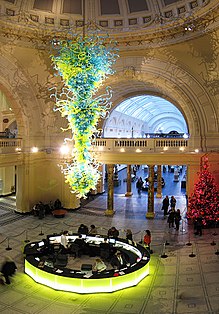American craft

American craft is craft work produced by independent studio artists working with traditional
works tend to either serve or allude to a functional or utilitarian purpose, although they are just as often handled and exhibited in ways similar to visual art objects.History
The American studio craft movement is a successor to earlier European craft movements. Modern studio crafts developed as a reaction to

American craft pioneers
In the early nineteenth century it became popular for rural Americans of modest means to take the decoration of their homes and furniture into their own hands. The artist Rufus Porter was an early proponent of the American craft movement. In 1825 he published A Select Collection of Valuable and Curious Arts, and Interesting Experiments Which are Well Explained, and Warranted Genuine, and May be Prepared, Safely and at Little Expense, which is a book of instructions for domestic decorative arts, including wall, floor, and furniture painting.
By the end of the nineteenth century, the preindustrial craft trades had almost disappeared. Industrial expansion and westward movement had largely severed American culture from early Colonial American and Native American craft roots. Against this backdrop,
The
Early craft institutions
The studio crafts movement was fostered by the establishment of crafts programs within post-secondary educational institutions. In 1894, for example, North America's first
After World War I, a postwar spirit of internationalism influenced the establishment of other important craft institutions, such as the Cranbrook Academy of Art in Bloomfield Hills, Michigan. Cranbrook craftsmen translated organic and geometric forms into the style that would be known as Art Deco. At Cranbrook, teachers like Maija Grotell produced important work in their own right while also teaching a new generation of young studio craft artists.
The Depression years and World War II
During the Depression years, the federal Works Progress Administration funded crafts projects as well as public works and murals as a way to both keep workers working and as a way to increase national morale. This enabled crafts to flourish at a local level. At the same time, American art programs began to include craft studies into their curricula.
World War II brought an influx of European artists and craftsmen. These European exiles brought with them a range of historical traditions including not only European craft practices but also knowledge of Asian and other non-Western cultures. One example of this influx is Tage Frid, a Danish furniture maker, who established the reputation of the Furniture Making program at Rhode Island School of Design, and there are certainly others. Also during the post World War II period a general dissatisfaction with industrial society began to fuel further support for handmade art objects. In 1943, the American Craft Council was founded to support craftspeople and cultivate an appreciation for their work. The ACC's founder, Aileen Osborn Webb was a potter interested in creating marketing opportunities for studio craftsmen. The organization eventually grew to include American Craft magazine and the Museum of Arts and Design (then called the Museum of Contemporary Crafts and at one point known as the American Craft Museum). As a result of these phenomena, post-war American craft became stylistically more refined as well as technically more proficient.
The 1950s and Peter Voulkos

During the 1950s, some artists turned to the truth-to-materials doctrine.[
Voulkos was also influenced by
Voulkos taught at
The 1960s and the new glassblowing movement
The culture of the 1960s was even more conducive to the development of studio crafts. This period saw a rejection of
In 1971,
The Renwick Gallery

In 1972, the
The Year of American Craft
In 1992,
Types
- American Craftsman
- American Fancy
- Appalachian Spring (store)
- Applied art
- Art nouveau
- Art quilts
- Art deco
- Arts and crafts
- Blacksmithing
- Ceramics
- Craft
- Decorative arts
- Fiber art
- Glass art
- Glass blowing
- Handicraft
- History of decorative art
- Mosaic
- Quilt
- Studio craft
- Studio Furniture
- Studio pottery
- Woodturning
Notes
- ^ Timothy Anglin Burgard, The Art of Craft: Contemporary Works from the Saxe Collection, Fine Arts Museums of San Francisco, 1999 at 13
- ^ The Corning Museum of Glass. "Decades in Glass: The '60s."
Sources
- Biography.com Peter Voulkos Biography (1924–2002) (Retrieved 2007-09-01)
- Timothy Anglin Burgard, The Art of Craft: Contemporary Works from the Saxe Collection. ISBN 0-8212-2637-1(hardcover).
- Barbaralee Diamonstein, "Values, Skills and Dreams: Crafts in America", in Michael Monroe, The White House Collection of American Crafts, ISBN 0-8109-4035-3.
- Julie Hall, Tradition and Change: The New American Craftsman, ISBN 0-525-22195-6.
- Kenneth Trapp and Howard Risatti, Skilled Work: American Craft in the Renwick Gallery. Smithsonian Institution Press, 1998. ISBN 1-56098-806-1
- Pohl, Francis K. Framing America. A Social History of American Art. New York: Thames and Hudson, 2002 (pages 118–122)
External links
- American Craft magazine
- American crafts
- American Craft Council
- Renwick Gallery official website
- Redefining Craft
- AmericanStyle magazine
- Museum of Arts and Design
- The Journal of Modern Craft
- International Expositions of Sculpture Objects and Functional Art, Chicago and New York
- American Furniture in The Metropolitan Museum of Art, a fully digitized 2 volume exhibition catalog
